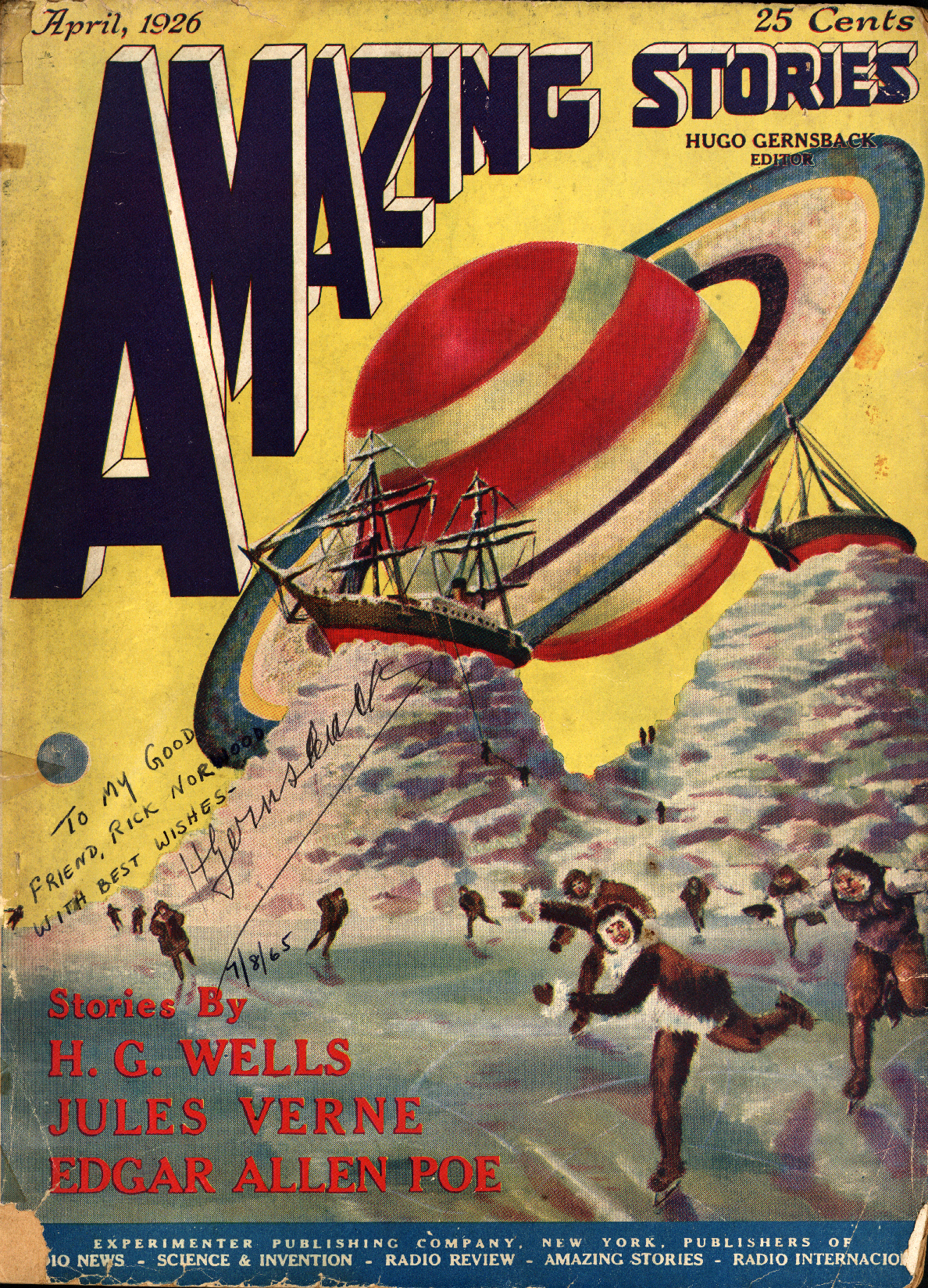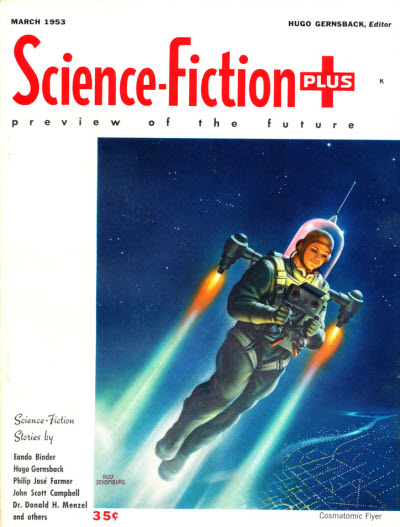|
Bedsheet
The bedsheet format (also known as large pulp) was the size of many magazines published in the United States in the first quarter of the 20th century. Magazines in bedsheet format were roughly the size of ''Life'' but with square spines. While the bedsheet size varied slightly from magazine to magazine, a standard bedsheet size is usually 9¾" x 12". Dick Eney's ''Fancyclopedia II'' gives the following entry: :Bedsheet: A prozine size; 9x12. At various times ''Amazing'', ''Wonder'', ''Fantastic Adventures'', ''ASF'' and ''Unknown Worlds'' attempted this size. The two latter, at least, were cut down by wartime paper shortage, and possibly by the keening of collectors who found these dimensions accident-prone. The first science fiction magazine, ''Amazing Stories'', was published in a bedsheet format. Later, most magazines changed to the pulp magazine format, roughly the size of comic books or ''National Geographic'' but again with a square spine. Now, many magazines are published i ... [...More Info...] [...Related Items...] OR: [Wikipedia] [Google] [Baidu] |
Science Fiction Magazine
A science fiction magazine is a publication that offers primarily science fiction, either in a hard-copy periodical format or on the Internet. Science fiction magazines traditionally featured speculative fiction in short story, novelette, novella or (usually serialized) novel form, a format that continues into the present day. Many also contain editorials, book reviews or articles, and some also include stories in the fantasy and horror genres. History of science fiction magazines Malcolm Edwards and Peter Nicholls write that early magazines were not known as science fiction: "if there were any need to differentiate them, the terms scientific romance or 'different stories' might be used, but until the appearance of a magazine specifically devoted to sf there was no need of a label to describe the category. The first specialized English-language pulps with a leaning towards the fantastic were '' Thrill Book'' (1919) and ''Weird Tales'' (1923), but the editorial policy of ... [...More Info...] [...Related Items...] OR: [Wikipedia] [Google] [Baidu] |
Fantastic Adventures
''Fantastic Adventures'' was an American pulp fantasy and science fiction magazine, published from 1939 to 1953 by Ziff-Davis. It was initially edited by Raymond A. Palmer, who was also the editor of ''Amazing Stories'', Ziff-Davis's other science fiction title. The first nine issues were in bedsheet format, but in June 1940 the magazine switched to a standard pulp size. It was almost cancelled at the end of 1940, but the October 1940 issue enjoyed unexpectedly good sales, helped by a strong cover by J. Allen St. John for Robert Moore Williams' ''Jongor of Lost Land''. By May 1941 the magazine was on a regular monthly schedule. Historians of science fiction consider that Palmer was unable to maintain a consistently high standard of fiction, but ''Fantastic Adventures'' soon developed a reputation for light-hearted and whimsical stories. Much of the material was written by a small group of writers under both their own names and house names. The cover art, like those of many other ... [...More Info...] [...Related Items...] OR: [Wikipedia] [Google] [Baidu] |
Unknown (magazine)
''Unknown'' (also known as ''Unknown Worlds'') was an American pulp fantasy fiction magazine, published from 1939 to 1943 by Street & Smith, and edited by John W. Campbell. ''Unknown'' was a companion to Street & Smith's science fiction pulp, ''Astounding Science Fiction'', which was also edited by Campbell at the time; many authors and illustrators contributed to both magazines. The leading fantasy magazine in the 1930s was ''Weird Tales'', which focused on shock and horror. Campbell wanted to publish a fantasy magazine with more finesse and humor than ''Weird Tales'', and put his plans into action when Eric Frank Russell sent him the manuscript of his novel '' Sinister Barrier'', about aliens who own the human race. ''Unknown''s first issue appeared in March 1939; in addition to ''Sinister Barrier'', it included H. L. Gold's "Trouble With Water", a humorous fantasy about a New Yorker who meets a water gnome. Gold's story was the first of many in ''Unknown'' to combine commonpl ... [...More Info...] [...Related Items...] OR: [Wikipedia] [Google] [Baidu] |
Amazing Stories
''Amazing Stories'' is an American science fiction magazine launched in April 1926 by Hugo Gernsback's Experimenter Publishing. It was the first magazine devoted solely to science fiction. Science fiction stories had made regular appearances in other magazines, including some published by Gernsback, but ''Amazing'' helped define and launch a new genre of pulp fiction. As of 2018, ''Amazing'' has been published, with some interruptions, for 92 years, going through a half-dozen owners and many editors as it struggled to be profitable. Gernsback was forced into bankruptcy and lost control of the magazine in 1929. In 1938 it was purchased by Ziff-Davis, who hired Raymond A. Palmer as editor. Palmer made the magazine successful though it was not regarded as a quality magazine within the science fiction community. In the late 1940s ''Amazing'' presented as fact stories about the Shaver Mystery, a lurid mythos that explained accidents and disaster as the work of robots named deros, w ... [...More Info...] [...Related Items...] OR: [Wikipedia] [Google] [Baidu] |
Wonder Stories
''Wonder Stories'' was an early American science fiction magazine which was published under several titles from 1929 to 1955. It was founded by Hugo Gernsback in 1929 after he had lost control of his first science fiction magazine, ''Amazing Stories'', when his media company Experimenter Publishing went bankrupt. Within a few months of the bankruptcy, Gernsback launched three new magazines: ''Air Wonder Stories'', ''Science Wonder Stories'', and ''Science Wonder Quarterly''. ''Air Wonder Stories'' and ''Science Wonder Stories'' were merged in 1930 as ''Wonder Stories'', and the quarterly was renamed ''Wonder Stories Quarterly''. The magazines were not financially successful, and in 1936 Gernsback sold ''Wonder Stories'' to Ned Pines at Beacon Publications, where, retitled ''Thrilling Wonder Stories'', it continued for nearly 20 years. The last issue was dated Winter 1955, and the title was then merged with '' Startling Stories'', another of Pines' science fiction magazines. ... [...More Info...] [...Related Items...] OR: [Wikipedia] [Google] [Baidu] |
Astounding
''Analog Science Fiction and Fact'' is an American science fiction magazine published under various titles since 1930. Originally titled ''Astounding Stories of Super-Science'', the first issue was dated January 1930, published by William Clayton (publisher), William Clayton, and edited by Harry Bates (author), Harry Bates. Clayton went bankrupt in 1933 and the magazine was sold to Street & Smith. The new editor was F. Orlin Tremaine, who soon made ''Astounding'' the leading magazine in the nascent pulp science fiction field, publishing well-regarded stories such as Jack Williamson's ''Legion of Space Series, Legion of Space'' and John W. Campbell's Twilight (Campbell short story), "Twilight". At the end of 1937, Campbell took over editorial duties under Tremaine's supervision, and the following year Tremaine was let go, giving Campbell more independence. Over the next few years Campbell published many stories that became classics in the field, including Isaac Asimov's Foun ... [...More Info...] [...Related Items...] OR: [Wikipedia] [Google] [Baidu] |
The Witch's Tales
''The Witch's Tales'' was an American pulp magazine edited by Tom Chadburn which published two issues in November and December 1936. It was a companion to a radio program, called '' The Witch's Tale'', which had begun broadcasting in May 1931. With the exception of the lead story in each issue, all the stories were reprints from the American edition of ''Pearson's Magazine''. Alonzo Deen Cole, who wrote the radio series, contributed one lead story, and provided the plot for the other. The authors of the reprint stories included George Daulton, Wardon Allan Curtis, William Hamilton Osborne, and John C. Haywood. Publication history and contents '' The Witch's Tale'' was a radio program that began on American radio in May 1931. A weekly anthology show, it was the first radio horror program, and soon became quite popular. In 1936, the magazine ''The Witch's Tales'' appeared as a companion to it, perhaps inspired by ''The Shadow'', a successful pulp magazine which had also ... [...More Info...] [...Related Items...] OR: [Wikipedia] [Google] [Baidu] |
Digest Size
Digest size is a magazine size, smaller than a conventional or "journal size" magazine but larger than a standard paperback book, approximately , but can also be and , similar to the size of a DVD case. These sizes have evolved from the printing press operation end. Some printing presses refer to digest-size as a "catalog size". The digest format was considered to be a convenient size for readers to tote around or to leave on the coffee table within easy reach. Examples The most famous digest-sized magazine is ''Reader's Digest'', from which the size appears to have been named. ''TV Guide'' also used the format from its inception in 1953 until 2005. ''CoffeeHouse Digest'' is a national magazine distributed free of charge at coffeehouses throughout the United States. ''Bird Watcher's Digest'' is an international magazine that has retained the digest size since its creation in 1978. Digest size is less popular now than it once was. ''TV Guide'' dropped it in favor of a larger for ... [...More Info...] [...Related Items...] OR: [Wikipedia] [Google] [Baidu] |
Staple (fastener)
A staple is a type of two-pronged fastener, usually metal, used for joining or binding materials together. Large staples might be used with a hammer or staple gun for masonry, roofing, corrugated boxes and other heavy-duty uses. Smaller staples are used with a stapler to attach pieces of paper together; such staples are a more permanent and durable fastener for paper documents than the paper clip. Etymology The word "staple" originated in the late thirteenth Century, from Old English ''stapol'', meaning "post, pillar". The word's first usage in the paper-fastening sense is attested from 1895. History In ancient times, the staple had several different functions. Large metal staples dating from the 6th century BC have been found in the masonry works of the Persian empire (ancient Iran). For the construction of the Pasargadae and later Ka'ba-ye Zartosht, these staples, which are known as "dovetail" or "swallowtail" staples, were used for tightening stones together. The ho ... [...More Info...] [...Related Items...] OR: [Wikipedia] [Google] [Baidu] |
Science-Fiction Plus
''Science-Fiction Plus'' was an American science fiction magazine published by Hugo Gernsback for seven issues in 1953. In 1926, Gernsback had launched ''Amazing Stories,'' the first science fiction magazine, but he had not been involved in the genre since 1936, when he sold ''Wonder Stories''. ''Science-Fiction Plus'' was initially in slick format, meaning that it was large-size and printed on glossy paper. Gernsback had always believed in the educational power of science fiction, and he continued to advocate his views in the new magazine's editorials. The managing editor, Sam Moskowitz, had been a reader of the early pulp magazines, and published many writers who had been popular before World War II, such as Raymond Z. Gallun, Eando Binder, and Harry Bates. Combined with Gernsback's earnest editorials, the use of these early writers gave the magazine an anachronistic feel. Sales were initially good, but soon fell. For the last two issues Gernsback switched the magazin ... [...More Info...] [...Related Items...] OR: [Wikipedia] [Google] [Baidu] |
Magazine
A magazine is a periodical publication, generally published on a regular schedule (often weekly or monthly), containing a variety of content. They are generally financed by advertising, purchase price, prepaid subscriptions, or by a combination of the three. Definition In the technical sense a ''journal'' has continuous pagination throughout a volume. Thus '' Business Week'', which starts each issue anew with page one, is a magazine, but the '' Journal of Business Communication'', which continues the same sequence of pagination throughout the coterminous year, is a journal. Some professional or trade publications are also peer-reviewed, for example the '' Journal of Accountancy''. Non-peer-reviewed academic or professional publications are generally ''professional magazines''. That a publication calls itself a ''journal'' does not make it a journal in the technical sense; ''The Wall Street Journal'' is actually a newspaper. Etymology The word "magazine" derives from Arabic , ... [...More Info...] [...Related Items...] OR: [Wikipedia] [Google] [Baidu] |
Reader's Digest
''Reader's Digest'' is an American general-interest family magazine, published ten times a year. Formerly based in Chappaqua, New York, it is now headquartered in midtown Manhattan. The magazine was founded in 1922 by DeWitt Wallace and his wife Lila Bell Wallace. For many years, ''Reader's Digest'' was the best-selling consumer magazine in the United States; it lost the distinction in 2009 to '' Better Homes and Gardens''. According to Mediamark Research (2006), ''Reader's Digest'' reached more readers with household incomes of over $100,000 than ''Fortune'', ''The Wall Street Journal'', '' Business Week'', and '' Inc.'' combined. Global editions of ''Reader's Digest'' reach an additional 40 million people in more than 70 countries, via 49 editions in 21 languages. The periodical has a global circulation of 10.5 million, making it the largest paid-circulation magazine in the world. It is also published in Braille, digital, audio, and a large type called "Reader's Digest Larg ... [...More Info...] [...Related Items...] OR: [Wikipedia] [Google] [Baidu] |










